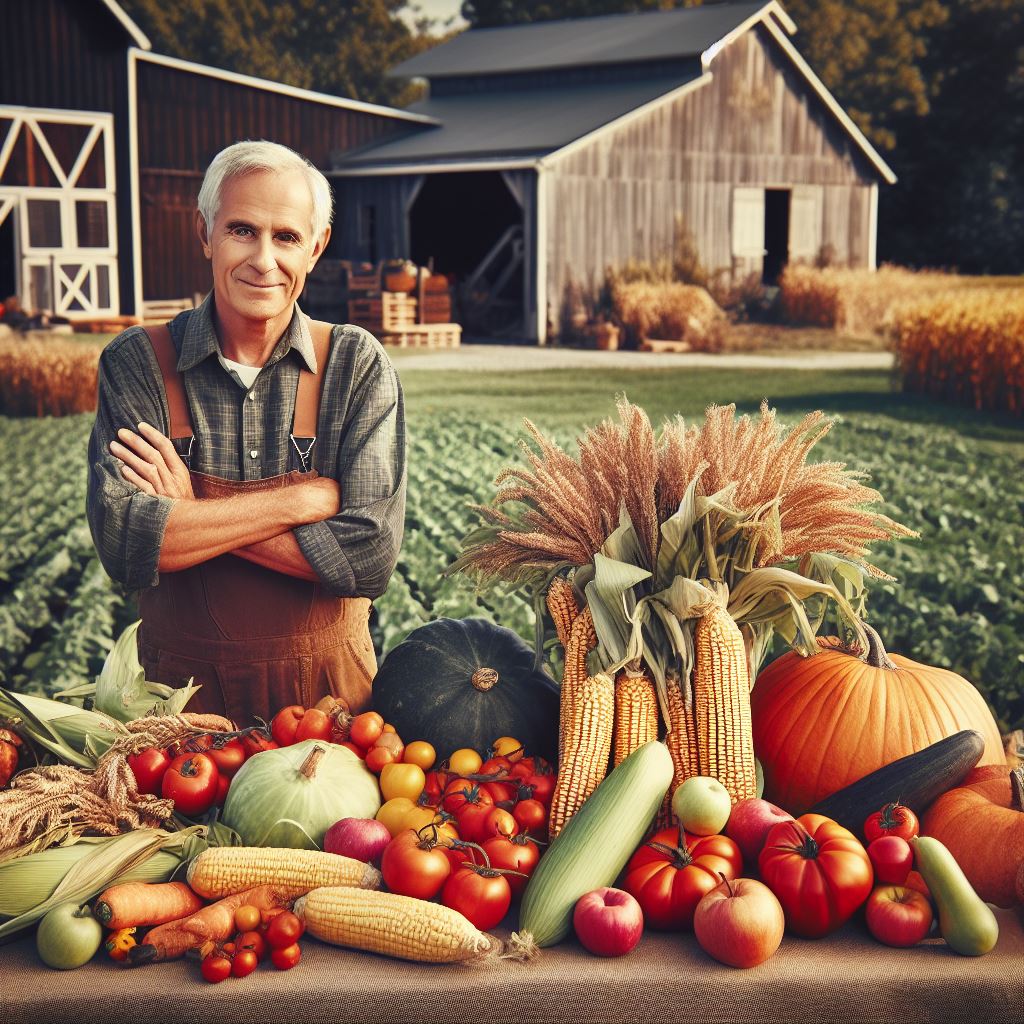Introduction
In today’s fast-paced world, it can be easy to overlook the importance of using fresh, farm produce in our cooking.
However, the quality and flavor of our meals greatly depend on the ingredients we use.
By incorporating fresh produce straight from the farm, we not only enhance the taste of our dishes but also support local agriculture.
There is an undeniable connection between farming and cooking.
The farming process produces the ingredients that end up on our plates.
When we choose to use fresh, farm produce, we are not only contributing to our own well-being but also to the sustainability of our environment.
The purpose of this blog post is to provide cooking tips that focus on utilizing farm produce.
By sharing knowledge and insights, we hope to inspire individuals to experiment with fresh ingredients and elevate their culinary experiences.
Whether it’s incorporating seasonal vegetables into a stir-fry or selecting the juiciest fruits for a delectable dessert, these tips will help you make the most of farm produce in your cooking.
Get ready to embark on a journey where farm-fresh flavors take center stage.
Join us as we explore various cooking techniques, recipes, and innovative uses for farm produce.
Together, let’s unlock the full potential of these nature’s gifts and create incredible dishes that tantalize our taste buds.
Selecting Fresh Farm Produce
Benefits of Using Fresh Farm Produce
- Enhances the flavor and taste of your dishes due to their freshness and quality.
- Provides higher nutritional value as fresh produce retains more vitamins and minerals.
- Supports local farmers and promotes sustainable farming practices.
Tips on How to Select the Best Farm Produce
- Look for vibrant colors and a fresh appearance, indicating the produce is at its peak.
- Check for firmness by gently pressing or squeezing the produce and avoid any soft spots.
- Examine for the absence of bruises or blemishes, as these indicate possible damage or spoilage.
- Smell the produce to ensure freshness. It should have a pleasant aroma specific to its type.
Importance of Buying Locally Sourced Farm Produce
Buying locally sourced farm produce has numerous benefits for both consumers and the environment:
- Fresher and more flavorful: Locally sourced produce doesn’t have to travel long distances, resulting in better taste and quality.
- Supports the local economy: By purchasing from local farmers, you contribute to their livelihood and the growth of your community.
- Environmental sustainability: Reduces carbon footprint due to decreased transportation requirements.
- Promotes seasonal eating: Local produce is often harvested at the peak of their season, maximizing taste and nutritional value.
- Builds connections and trust: Knowing where your food comes from fosters a sense of community and transparency.
Selecting fresh farm produce is crucial for ensuring the best quality and taste in your cooking.
By understanding the benefits of fresh produce, how to choose the best, and the importance of buying local, you can elevate your culinary experience while supporting local farmers and sustainable practices.
Transform Your Agribusiness
Unlock your farm's potential with expert advice tailored to your needs. Get actionable steps that drive real results.
Get StartedRead: Farmers Markets: Your Local Food Hub
Storing Farm Produce
When it comes to cooking with farm-fresh produce, proper storage is essential to maintain their freshness and quality.
By following general guidelines and specific storage tips for different types of farm produce, you can ensure that your ingredients stay fresh and delicious.
General guidelines for storing farm produce
- Keep produce in a cool and dry place: Most farm produce benefits from being stored in a cool and dry location. This helps to extend their shelf life and prevent spoilage.
- Some produce should be refrigerated, while others should be stored at room temperature: It’s important to know which fruits and vegetables are best kept in the refrigerator and which are better stored at room temperature. This will help maintain their freshness and flavors.
- Store produce away from ethylene-producing fruits to prevent premature ripening: Ethylene is a natural plant hormone that can accelerate the ripening process in fruits and vegetables. To prevent premature ripening, it’s best to store ethylene-sensitive produce away from ethylene-producing fruits.
Specific storage tips for different types of farm produce
- Leafy greens: Leafy greens, such as lettuce, spinach, and kale, should be stored differently than other produce. Remove any rubber bands or ties, as they can cause bruising. Wrap the greens in damp paper towels to maintain their moisture and store them in the refrigerator.
- Tomatoes: Tomatoes are best stored at room temperature, away from direct sunlight. If they are not yet fully ripe, you can place them in a paper bag to speed up the ripening process.
- Root vegetables: Root vegetables like carrots, potatoes, and beets should be stored in a cool and dark location. Ideally, they should be kept in a ventilated container or bag to prevent moisture buildup, which can lead to rotting.
By following these storage guidelines, you can make the most of your farm produce and minimize waste.
Proper storage ensures that your fruits and vegetables stay fresh, flavorful, and nutritious for longer periods of time.
In general, storing farm produce correctly is crucial in maintaining their quality and freshness.
By keeping certain fruits and vegetables refrigerated or at room temperature, and by storing them away from ethylene-producing fruits, you can prolong their shelf life.
Additionally, specific storage tips for leafy greens, tomatoes, and root vegetables help maintain their optimal conditions.
By taking these storage guidelines into consideration, you can enjoy the full flavor and nutritional benefits of farm produce from the moment it hits your plate.
Read: Sustainable Practices in Farm-to-Table

Explore Further: 2024 Calendar: Farm-to-Table Events
Delve into the Subject: Permaculture: Earth’s Best Friend
Preparing Farm Produce
The importance of washing farm produce before cooking
Before cooking farm produce, it is crucial to wash them thoroughly to remove any dirt, bacteria, or pesticides present on the surface.
Washing helps to ensure that the produce is clean and safe to eat.
How to properly wash different types of produce
- Leafy greens: Rinse under cold water, making sure to remove any dirt or debris. Dry them using a salad spinner or paper towels to remove excess moisture.
- Root vegetables: Scrub the skin with a brush under running water to remove any dirt or residue.
- Berries: Gently rinse under cold water, being careful not to crush them. Remove any stems or leaves attached to the berries.
The benefits of organic farm produce and how to properly handle them
Organic farm produce is grown without the use of synthetic pesticides, fertilizers, or genetically modified organisms (GMOs).
These foods are considered healthier options as they are free from harmful chemicals.
When handling organic produce:
- Do not mix organic and non-organic produce together to avoid cross-contamination.
- Store organic produce separately from non-organic produce to prevent chemical transfer.
- Keep organic produce refrigerated to maintain freshness and delay spoilage.
- Consume organic produce within a reasonable timeframe to enjoy maximum flavor and nutritional benefits.
By following these guidelines, you can ensure that your farm produce is clean, safe, and ready to be used in your delicious recipes.
Enjoy your cooking journey from farm to plate!
Read: Farm-to-Fork: Understanding the Chain
Cooking Techniques and Recipes
Basic Cooking Techniques for Farm Produce
- Stir-frying: Quickly cook farm produce in a hot pan with a small amount of oil.
- Roasting: Place farm produce in the oven and cook at high heat until tender and caramelized.
- Steaming: Use a steamer basket to cook farm produce over boiling water until crisp and tender.
- Grilling: Cook farm produce on a hot grill, giving them a smoky and charred flavor.
Farm Produce-Based Recipes
Farm-Style Vegetable Stir-Fry
- Heat oil in a wok, add mixed farm vegetables, stir-fry over high heat for 5 minutes.
- Add soy sauce, garlic, ginger, and chili flakes. Continue to stir-fry for another 2 minutes.
- Serve hot with steamed rice.
Roasted Root Vegetable Medley
- Preheat oven to 400°F. Peel and chop a mix of root vegetables like carrots, potatoes, and beets.
- Toss vegetables with olive oil, salt, and pepper, then spread on a baking sheet.
- Roast for 25-30 minutes until vegetables are tender and golden.
Steamed Green Beans with Lemon Zest
- Steam green beans until they are tender-crisp, about 5 minutes.
- Transfer to a serving dish and sprinkle with lemon zest, salt, and a drizzle of olive oil.
Grilled Corn on the Cob with Herb Butter
- Preheat grill to medium heat. Peel back husks from corn but leave them attached.
- Remove silk strands, re-wrap husks around corn, and soak in water for 10 minutes.
- In a small bowl, mix softened butter with chopped fresh herbs and salt.
- Grill corn for 15-20 minutes, turning occasionally. Brush with herb butter before serving.
By using these basic cooking techniques and trying out these recipes, you can easily transform farm produce into delicious and healthy meals.
Stir-frying quickly cooks vegetables while retaining their natural flavors and textures. Roasting brings out the sweetness in root vegetables and adds depth to their taste.
Steaming preserves the nutrients and vibrant colors of green beans. Grilling adds a smoky flavor to corn on the cob, enhancing its natural sweetness.
Once you have mastered these techniques, you can get creative with your own farm produce-based recipes.
Showcase Your Farming Business
Publish your professional farming services profile on our blog for a one-time fee of $200 and reach a dedicated audience of farmers and agribusiness owners.
Publish Your ProfileExperiment with different combinations of vegetables, herbs, and spices to find your favorite flavor profiles.
Remember to support your local farmers and enjoy the freshness and quality of farm produce in your meals.
So, next time you have farm produce in your kitchen, don’t hesitate to try these cooking techniques and recipes.
From a farm-style vegetable stir-fry to a grilled corn on the cob with herb butter, the possibilities are endless. Get ready to savor the flavors and goodness of farm-to-plate cooking!
Read: Seasonal Eats: What Farm-to-Table Offers
Conclusion
Using fresh farm produce in cooking is crucial for taste and nutritional value.
It infuses vibrant flavors, enriches textures, and enhances overall meal quality.
Incorporating farm produce into meals enhances flavors and promotes a healthy lifestyle.
From increased nutrient intake to supporting local economies, the advantages are vast.
Visit local farms to witness the source of their ingredients, fostering a connection with sustainable agriculture.
It is important to support sustainable agriculture by visiting local farms and buying their products.
Support local farmers for a greener tomorrow.




